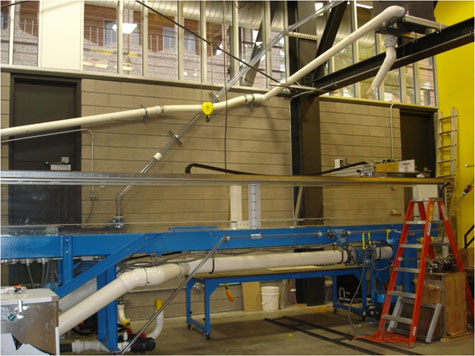| Abrasion by Bedload and Suspended Load: Experimental Study |
 |
Project Summary
Personnel: Phairot Chatanantavet (Ph.D.) Mark Adams Andrew Darling River incision into bedrock is one of the fundamental drivers of landscape evolution but occurs relatively slowly and during infrequent flood events, making it difficult to investigate. There has been considerable progress in the past decade on understanding the role of bedrock channels in long-term landscape evolution, but this has been accomplished primarily with generic rule sets for river incision that lump together a diverse set of erosional mechanisms (stream power models). These models start from the premise that erosion rate increases with increasing shear stress. A recently developed physically-based model of bedrock abrasion by bedload (Sklar and Dietrich, 1998, 2004), however, predicts rather that erosion rate depends strongly on bedload sediment flux, as modulated by the extent of alluvial bed cover, and, all else held equal, decreases with increasing shear stress. This suggests that much of the analysis of the interactions among climate, tectonics, and topography completed using simple stream power models needs to be re-assessed. But this model too, of course, rests on simplifying assumptions and must be tested, and probably refined, before its predictions are broadly accepted and incorporated into landscape evolution theory, as suggested by the theoretical extension of this model to handle suspended-load abrasion (Lamb et al., 2008) Our previous experimental work has quantitatively confirmed that incision rate increases linearly with sediment flux, and decreases with bedcover, as predicted. But the aspects of the saltation-abrasion model that most differentiate its predictions from those of the stream-power models – the prediction that erosion rate decreases with bed shear stress, reaching near-zero as sediment goes into suspension – have not yet been demonstrated and, indeed, have been questioned by Lamb et al. (2008). Further, these model predictions rest on the two most limiting assumptions in the saltation-abrasion model: that the river bed is perfectly planar, and that the sediment is very well sorted. Both are often violated in nature and these violations may fundamentally change the expected relationship between shear stress and erosion rate. Experimental results to date, while incomplete, bear out this inference and suggest a complex interplay among bed topography, sediment size distribution, fluid discharge, and bed slope. Johnson and Whipple (in review) report that incision rate is independent of water discharge (neither increasing as predicted by stream power models, nor decreasing as predicted by the saltation-abrasion model). Johnson and Whipple (2007) and Chatanantavet and Parker (2006), however, report that incision rate increases with bed slope (as predicted by simple stream power models). Two ways of manipulating bed shear stress produced markedly different results, suggesting a rich behavior not captured by existing models. We propose an experimental study at ASU to complement and extend our previous flume experiments. We plan to vary the primary controlling variables (flux and size distribution of sediment; channel slope; water discharge; and substrate hardness) in a systematic exploration of parameter space, including the transition from bedload to suspended load transport. Bed morphology will be allowed to evolve naturally, and the critical feedbacks between bed morphology, fluid dynamics, sediment flux, and local erosion rate will be quantified. Based on preliminary experiments, field observations, and previous numerical studies, we formulate six quantitative hypotheses that can and will be tested by direct measurement of erosion rate, bed topography, grain saltation trajectories, sediment transport rate, and fluid flow conditions, allowing refinement of current theory. |
|
Experimental
Flume Lab
|
Previous Projects |